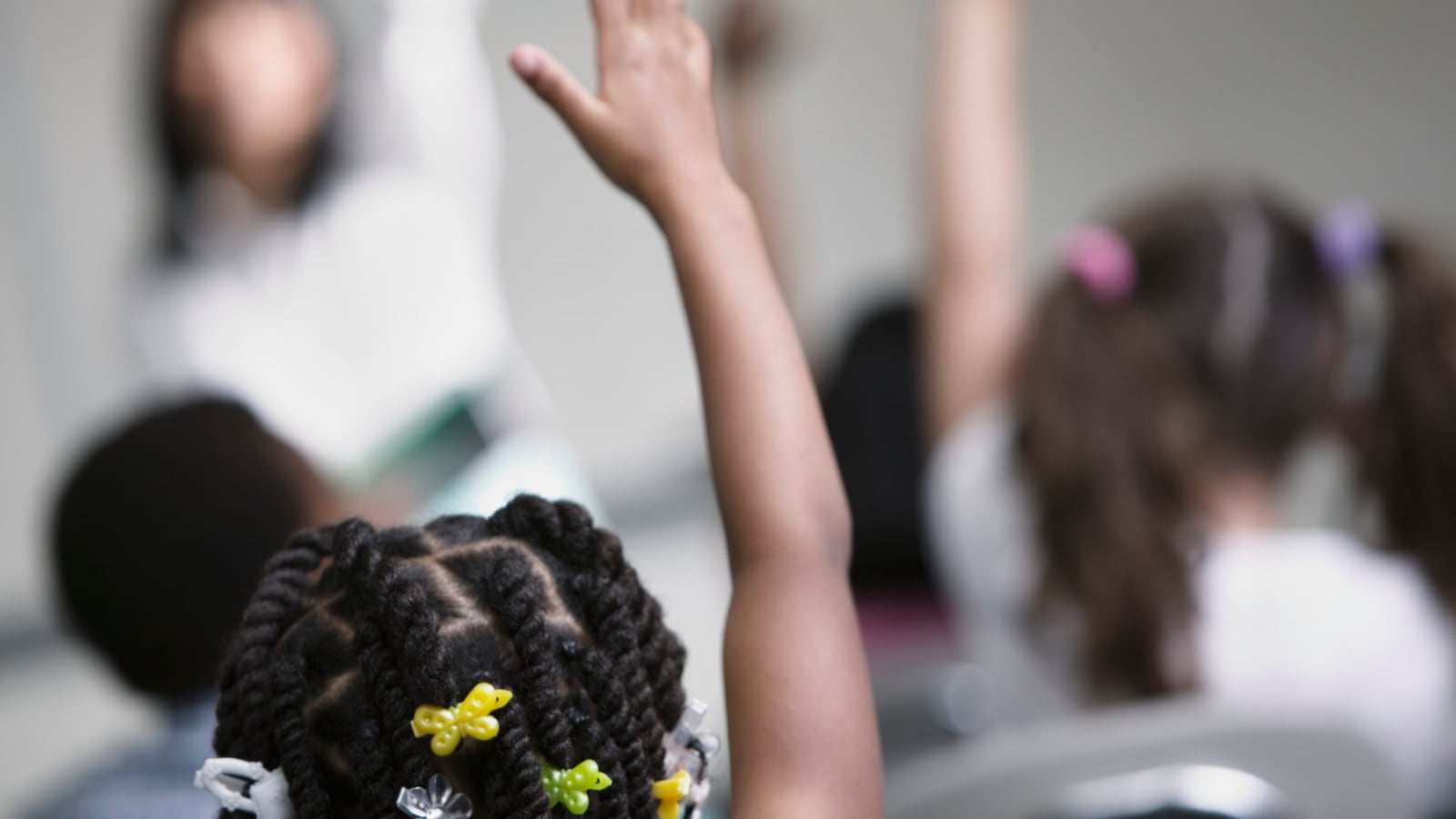Even though Illinois schools are increasingly diversifying, the state’s teaching ranks remain stubbornly white, according to new data from the Illinois Report Card.
Efforts to recruit a more diverse group of teachers haven’t moved the needle forward much in recent years. And in Chicago, the ranks of black teachers continues to decline, and the percentage of Latino teachers has only increased slightly.
Still, when it comes to the diversity of the workforce, Chicago does better than the rest of the state, even though the percentages of black and Latino teachers don’t come close to matching the diversity of the district’s students. This comes despite plenty of evidence to the benefits. Studies show better academic and social-emotional outcomes when students have a teacher from a similar cultural background, especially black and Latino students.
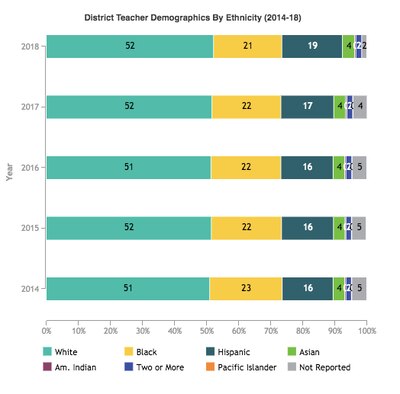
Robert Muller, dean of the National College of Education at National Louis University, said his institution is one of many wrestling with the question of how to bring more people of color into the teaching profession. But overall, “the composition of the pipeline has not shifted dramatically in recent years.”
He said that focusing on supporting diverse new teachers with mentoring and other supports early in their first few years on the job could address “leaks” in the teacher pipeline. Muller contends that keeping, not just hiring black teachers, is one of the district’s biggest diversity problems.
Of the 214 new black teachers hired in the 2015 fiscal year, only 51 percent were still working at the district by their third year, compared to 69 percent of Latino teachers and 53 percent of white teachers, whom it’s important to note, accounted for three out of every five new teachers, according to district human resource data.
The one-year retention rate for all new teachers in the 2017 fiscal year was 80 percent, but the retention rate for new black teachers was about 4 percentage points below that, the lowest among the three biggest racial groups at the district.
Christine Geovanis, spokeswoman for the Chicago Teachers Union, attributed some of the decline in black teachers to Chicago Board of Education policies, citing several ongoing federal civil rights lawsuits against the district and city.
One suit claims school closings and turnarounds since 2000 have had “a disparate impact on African-American tenured teachers and staff” on the South and West sides of the city, where a majority of the teachers worked. The suit notes the board closed about 140 schools from 2001 to 2013, and since 2006 has put about three dozen schools through turnarounds, in which school faculty and leadership are replaced in schools deemed underperforming. Another suit claims that a round of layoffs in 2011 that shed more than 900 classroom teachers disproportionately impacted African-Americans.
A closer look at the numbers
Statewide, 83 percent of all teachers are white, a decrease of only 2 percentage points in the past decade. Black and Hispanic teachers make up about 6 percent each, and Asian teachers 1.5 percent. About three in four candidates for teaching positions in the state identifies as white.
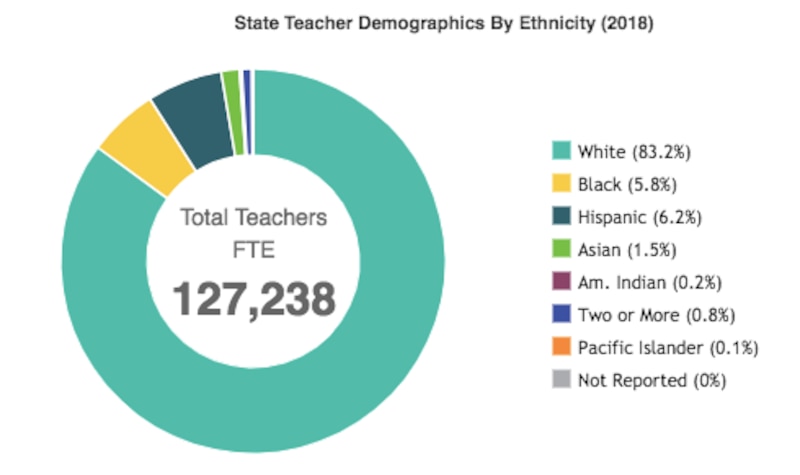
The state’s student population is about half white. The percentage of students of color in Illinois has grown from 46 percent to 52 percent since 2008.
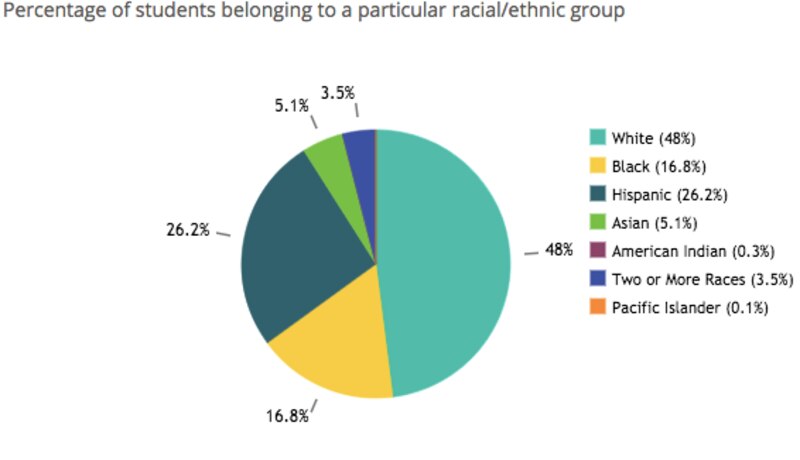
Of the 10 biggest school districts in Illinois by enrollment, Chicago has the lowest percentage of white teachers, about 52 percent.
Racial make-up of 10 biggest school districts in Illinois
In Chicago Public Schools, 47 percent of students are Latino, 37 percent are black, and 10 are percent white. Among teachers, 19 percent are Latino, and 52 percent white. About 21 percent of teachers are black, down from about 41 percent in 2000.
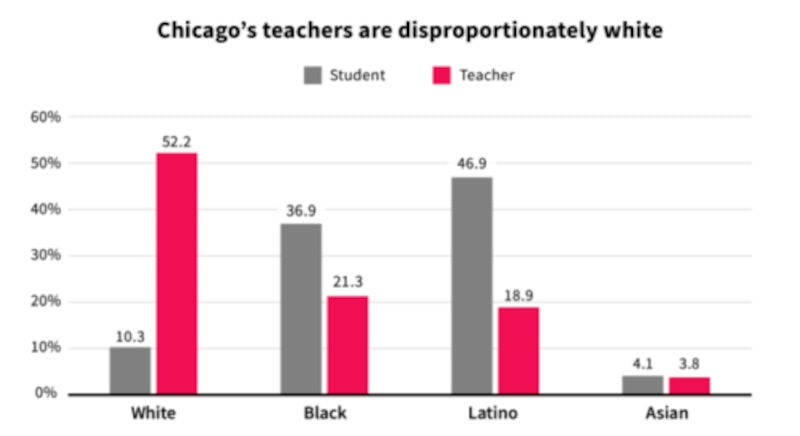
A matter of equity
Matt Lyons, chief talent officer at Chicago Public Schools, acknowledged the district faces major challenges in shifting racial balances, the biggest being that fewer people are training to be educators.
“All of our data show that we actually are hiring non-white teacher candidates,” Lyons said. “The challenge is there aren’t enough of them.”
The decline has been particularly notable among black teachers. There are already racial gaps in college completion and teacher prep enrollment to contend with. The number of African-Americans statewide graduating with degrees in education has dropped by more than half, from 1,724 in 2009 to 802 in 2016, according to the Illinois Board of Higher Education.
The district is trying out several tactics for boosting the number of Latino and black teachers. Among them is a teacher residency program launched last year with National Louis University and Relay Graduate School of Education that targets individuals looking to transition to the education field and paraprofessionals already working in classrooms who want to be full-time teachers. Tapping into that pool of classroom support staff is key because those employees tend to include more people of color.
The district is relaunching and expanding teaching academies at high schools, which prepare students to pursue an education degree, and has partnerships with teacher training programs that place special emphasis on recruiting people of color. Experts said that diversifying the teacher pipeline starts with improving the work conditions and changing the narrative around teaching, and connecting students with the idea of a rewarding and viable career in education as early as high school.
Hiring more black and Latino teachers isn’t just a matter of fairness or progressive sensibilities. It’s a matter of student achievement and racial equity, said Elizabeth Todd-Breland, a professor at the University of Illinois at Chicago and author of the new book “A Political Education: Black Politics and Education Reform in Chicago Since the 1960s.”
Research shows that having teachers of color benefits students of color and white students alike. Students of color can have role models who look like them, and white students see their teachers of color as authority figures and professionals, countering some negative characterizations in the media.
Studies also show that when students have a teacher from a similar cultural background, attendance and test scores improve. Students are more likely to be held to high expectations, and less likely to suffer from teachers’ implicit bias — those unconscious, automatic stereotypes, and attitudes people foster that can influence decision making, such as the idea that certain ethnicities are inherently unintelligent, aggressive, or criminal. This bias plays out in disproportionately high disciplinary rates for black and Latino students, research shows.
The impact of having a teacher of the same ethnicity or race is especially powerful for talented black students, who studies show are admitted to gifted programs at a lower rate than other students. They are more likely to be identified by black teachers, according to the research.
Diversifying the teacher workforce is among the issues on the to-do list for Chicago’s new chief equity office, district CEO Janice Jackson told Chalkbeat in July. The department is now headed by former Tilden High School principal Maurice Swinney.
“If there is not a concerted effort in place to take an affirmative action to change the demographics of the teaching force, it will stay the same or get worse,” Todd-Breland said. “This new equity officer, this is one of their charges.”
Asked if the district had a robust plan for addressing the issue and engaging communities around it, Matt Lyons deferred to Swinney. Chalkbeat has on multiple occasions requested interviews with the official since he announced his promotion in September, but the school district has not yet made him available.

